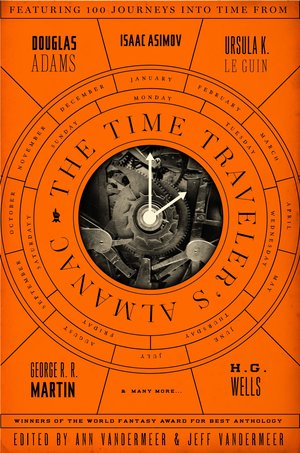Birthday Reviews: Edward Page Mitchell’s “The Clock That Went Backwards”

Edward Page Mitchell was born on March 24, 1852 and died on January 22, 1927. Mitchell wrote early science fiction stories for the New York Sun in the 1880s, including stories of invisibility, time travel, computers, and teleportation, predating the works of H.G. Wells. From 1897 to 1926 he served as editor for the Sun. While he was the Sun’s editor in 1897, the newspaper published Francis Pharcellus Church’s famous essay “Yes Virginia.”
“The Clock that Went Backward” first appeared anonymously in the Sun on September 18, 1881. Because it didn’t include Mitchell’s byline, for many years the story was ignored and not reprinted until Sam Moskowitz included it in The Crystal Man: Stories by Edward Page Mitchell, a collection of Mitchell’s science fiction published in 1973.
Isaac Asimov, Martin H. Greenberg, and Charles G. Waugh included it in Isaac Asimov Presents the Best Science Fictio of the 19th Century and it also appeared in Edel Brosnan’s The SF Collection and Peter Haining’s Timescapes: Stories of Time Travel. More recent reprints include in Chad Arment’s About Time, The Tachypomp and Other Stories, a collection of Mitchell’s science fiction, The Wordsworth Collection of Science Fiction, the audio anthology Short Science Fiction Collection 50, and Swords and Steam Short Stories, edited by Laura Bulbeck.
It is also available on Project Gutenberg. Ann and Jeff VanderMeer included the story in The Time Traveler’s Almanac, noting that it may be the first published time travel story, predating both “The Chronic Argonauts” and The Time Machine by H.G. Wells. The story has also been translated into Romanian.
Harry and the narrator are cousins who have spent considerable time with their Aunt, Gertrude. The most notable thing about Gertrude, beside her antiquity, is a stopped clock that she owns, which was made in 1572 in the city of Leyden in the Netherlands, where the family came from before immigrating to the United States. Following Gertrude’s death, when she willed the clock to Harry, the two travel to Leyden, with the clock, to attend university.
Naturally enough, with the guidance of one of their professors who could have been a distant ancestor, they use the clock to travel back to 1574 and the Siege of Leyden, where Harry rescues the daughter of Mayor Pieter Adriaanszoon Van der Werf and Professor van Stopp takes a key role in lifting the siege. The narrator returns to his native time, alone, and possibly the descendent of his cousin Harry.
Read nearly 140 years after its first publication, “The Clock That Went Backwards” seems basic and simplistic, mostly because Mitchell was inventing the subgenre and partly because the story was written for young boys. Interestingly, Mitchell implies several things in the story without making them explicit, but which shows that he did think through his premise.
Reprint reviewed in the anthology The Time Traveler’s Almanac, edited by Ann and Jeff VanderMeer, Tor Books, 2014.
 Steven H Silver is a fifteen-time Hugo Award nominee and was the publisher of the Hugo-nominated fanzine Argentus as well as the editor and publisher of ISFiC Press for 8 years. He has also edited books for DAW and NESFA Press. He began publishing short fiction in 2008 and his most recently published story is “Big White Men—Attack!” in Little Green Men—Attack! Steven has chaired the first Midwest Construction, Windycon three times, and the SFWA Nebula Conference 5 times, as well as serving as the Event Coordinator for SFWA. He was programming chair for Chicon 2000 and Vice Chair of Chicon 7. He has been the news editor for SF Site since 2002.
Steven H Silver is a fifteen-time Hugo Award nominee and was the publisher of the Hugo-nominated fanzine Argentus as well as the editor and publisher of ISFiC Press for 8 years. He has also edited books for DAW and NESFA Press. He began publishing short fiction in 2008 and his most recently published story is “Big White Men—Attack!” in Little Green Men—Attack! Steven has chaired the first Midwest Construction, Windycon three times, and the SFWA Nebula Conference 5 times, as well as serving as the Event Coordinator for SFWA. He was programming chair for Chicon 2000 and Vice Chair of Chicon 7. He has been the news editor for SF Site since 2002.